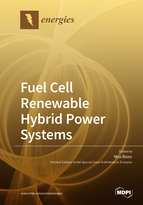Fuel Cell Renewable Hybrid Power Systems
A special issue of Energies (ISSN 1996-1073). This special issue belongs to the section "F: Electrical Engineering".
Deadline for manuscript submissions: closed (30 January 2021) | Viewed by 78452
Special Issue Editor
Interests: power electronics; renewable energy; fuel cell; hybrid power systems; control; optimization
Special Issues, Collections and Topics in MDPI journals
Special Issue Information
Dear Colleagues,
The very fast increase in the world’s energy demand over the last decade, and the request for sustainable development, can be approached using micro-grids based on hybrid power systems combining renewable energy sources and fuel cell systems.
Thus, to highlight the latest solutions in the implementation of Fuel cell renewable hybrid power systems, this Special Issue, entitled Fuel Cell Renewable Hybrid Power Systems, was proposed for the international journal Energies, which is an SCIE journal (2017 IF = 2.262). The present Special Issue of Energies aims to collect innovative solutions and experimental research, as well as state-of-the-art studies, in the following topics:
-Fuel cell (FC) systems: modeling, control, optimization, and innovative technologies to improve the fuel economy, lifetime, reliability, and safety in operation;
-Hybrid power systems (HPSs) based on renewable energy sources (RESs) (RES HPS): optimized RES HPSs architectures; global maximum power point tracking (GMPPT) control algorithms to improve energy harvesting from RESs; advanced energy management strategies (EMSs) to optimally ensure the power flow balance on DC (and/or AC bus) for stand-alone RES HPSs or grid-connected RES HPSs (micro-grids);
-RES HPS with an FC system as a backup energy source (FC RES HPS): innovative solutions to mitigate the RES power variability and load dynamics to energy storage systems (ESSs) by controlling the generated FC power, DC voltage regulation, and/or load pulses mitigation by active control of the power converters from hybrid ESS;
-FC vehicles (FCVs): FCV powertrain, ESSs topologies and hybridization technologies, and EMSs to improve the fuel economy;
-Optimal sizing of FC RES HPSs and FCVs;
The papers received are subject to a rigorous, but fast, peer review procedure, ensuring the wide dissemination of research results accepted for this Special Issue.
I am writing to invite you to submit your original work to this Special Issue. I am looking forward to receiving your outstanding research outcomes.
Prof. Dr. Nicu Bizon
Guest Editor
Manuscript Submission Information
Manuscripts should be submitted online at www.mdpi.com by registering and logging in to this website. Once you are registered, click here to go to the submission form. Manuscripts can be submitted until the deadline. All submissions that pass pre-check are peer-reviewed. Accepted papers will be published continuously in the journal (as soon as accepted) and will be listed together on the special issue website. Research articles, review articles as well as short communications are invited. For planned papers, a title and short abstract (about 100 words) can be sent to the Editorial Office for announcement on this website.
Submitted manuscripts should not have been published previously, nor be under consideration for publication elsewhere (except conference proceedings papers). All manuscripts are thoroughly refereed through a single-blind peer-review process. A guide for authors and other relevant information for submission of manuscripts is available on the Instructions for Authors page. Energies is an international peer-reviewed open access semimonthly journal published by MDPI.
Please visit the Instructions for Authors page before submitting a manuscript. The Article Processing Charge (APC) for publication in this open access journal is 2600 CHF (Swiss Francs). Submitted papers should be well formatted and use good English. Authors may use MDPI's English editing service prior to publication or during author revisions.
Keywords
- Hybrid power systems (HPSs)
- Renewable energy sources (RESs)
- Fuel cell (FC) systems
- Energy management strategies (EMSs)
- Hybrid energy storage systems (HESSs)
- Fuel cell vehicles (FCVs)
- Global maximum power point tracking (GMPPT)
- FC RES micro-grids
- System and process design of FC RES HPS
- Fuel economy, lifetime, reliability, and safety in operation of FC RES HPS






